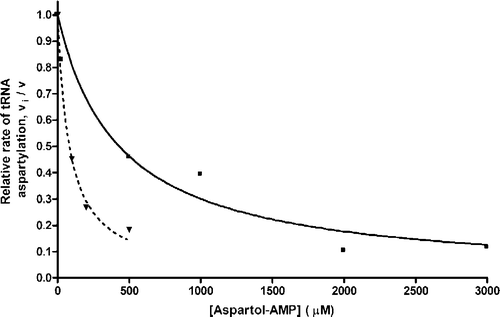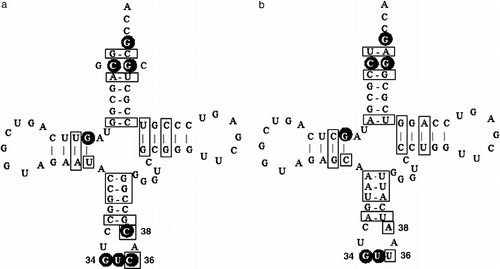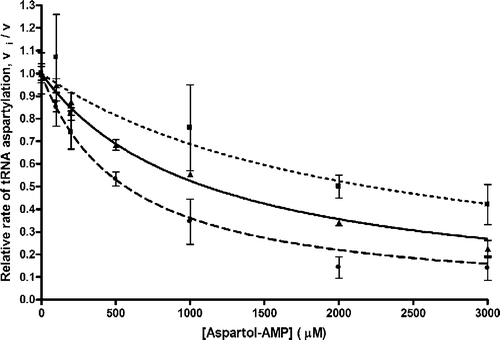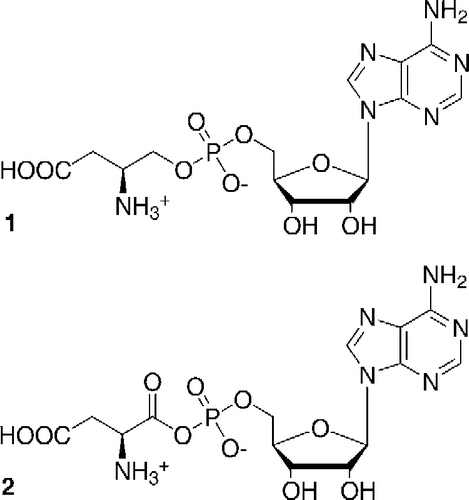Abstract
Asparaginyl-tRNA formation in Pseudomonas aeruginosa PAO1 involves a nondiscriminating aspartyl-tRNA synthetase (ND-AspRS) which forms Asp-tRNAAsp and Asp-tRNAAsn, and a tRNA-dependent amidotransferase which transamidates the latter into Asn-tRNAAsn. We report here that the inhibition of this ND-AspRS by L-aspartol adenylate (Asp-ol-AMP), a stable analog of the natural reaction intermediate L-aspartyl adenylate, is biphasic because the aspartylation of the two tRNA substrates of ND-AspRS, tRNAAsp and tRNAAsn, are inhibited with different Ki values (41 μM and 215 μM, respectively). These results reveal that the two tRNA substrates of ND-AspRS interact differently with its active site. Yeast tRNAAsp transcripts with some identity elements replaced by those of tRNAAsn have their aspartylation inhibited with Ki values different from that for the wild-type transcript. Therefore, aminoacyl adenylate analogs, which are competitive inhibitors of their cognate aminoacyl-tRNA synthetase, can be used to probe rapidly the role of various structural elements in positioning the tRNA acceptor end in the active site.
Introduction
Transfer RNA (tRNA) aminoacylation is the first step of protein biosynthesis. In extant organisms, this step is carried out by a set of aminoacyl-tRNA synthetases (aaRS) whose specific interactions with their cognate tRNAs are crucial for the faithful translation of the genetic information. Most tRNAs are directly aminoacylated correctly by a cognate aaRS, but in some organisms, some tRNAs are first misacylated by a nondiscriminating aaRS (ND-aaRS) Citation1-2, as in Pseudomonas aeruginosa PAO1 where tRNAAsn is aspartylated by an ND-AspRS [Citation3]. The incorrect aminoacyl group is then modified on the tRNA to generate a correctly-acylated tRNA; in the case mentioned, a tRNA-dependent amidotransferase (AdT) [Citation4] converts aspartyl-tRNAAsn into asparaginyl-tRNAAsn [Citation3].
Phylogenetic and structural studies indicate that asparaginyl-tRNA synthetases (AsnRS) emerged from the duplication and divergent evolution of such an ancestral ND-AspRS Citation1Citation5-6. The main identity elements of tRNAAsp for discriminating AspRSs (D-AspRS, such as that of Escherichia coli), and those of tRNAAsn for AsnRS are the anticodon and the discriminator base, and are conserved in evolution Citation7-8. They share the same discriminator base (G73) and the two first anticodon bases (G34 and U35), but differ at position 36. Other minor identity elements, such as C38 present in Thermus thermophilus and yeast, are species-specific. As P. aeruginosa ND-AspRS aspartylates both tRNAAsp and tRNAAsn, one could expect a high degree of similarity between their identity elements.
Asp-ol-AMP (1, in ), a stable analog of aspartyl adenylate (2), is a competitive inhibitor of E. coli D-AspRS with respect to aspartate, with an inhibition constant (Ki) of about 45 μM [Citation9]. Stable inhibitors of aaRSs have been helpful to produce high-quality crystals of these enzymes, and to study their reaction mechanism Citation10-11. Since no structures of bacterial ND-AspRS have been resolved yet, we tested the inhibitory properties of Asp-ol-AMP on the aspartylation of unfractionated P. aeruginosa tRNA by P. aeruginosa ND-AspRS.
Materials and methods
General
L-aspartol adenylate (Asp-ol-AMP) was synthesized as previously reported [Citation9]. The pUC18-derived plasmids expressing the wild-type, C36U and C38A variants of yeast tRNAAsp [Citation17] were provided by Richard Giegé and Catherine Florentz (IBMC-CNRS and Université Louis Pasteur, Strasbourg, France). [14C]aspartic acid was purchased from Amersham Biosciences, Ni-NTA resin from Qiagen Inc., BstNI and T7 RNA polymerase from New England Biolabs (NEB), RNase-free DNaseI from Ambion, and RNasin from Promega.
Purification Of P. Aeruginosa Asprs, Trnaasp And Trnaasn
The overproduction of the C-terminal histidine-tagged P. aeruginosa AspRS was done using a strain of P. aeruginosa ADD1976, harboring a plasmid expressing the aspS gene from P. aeruginosa PAO1, as previously described [Citation3], and purified to homogeneity using a nickel-containing resin (Ni-NTA). The tRNAAsn and the two tRNAAsp species were purified from unfractionated P. aeruginosa tRNA as hybrids with the 24-mer oligodeoxyribonucleotide probes 5′-GACCTGGACTCGAACCAGGGACCC-3′ and 5′-GGACGGGACTCGAACCCGCGACCC-3′ respectively, complementary to their respective T-arms, by polyacrylamide gel electrophoresis under nondenaturing conditions (the detailed experimental procedure will be published elsewhere). After removing the probe by denaturing PAGE, the tRNAAsp and tRNAAsn were recovered by electroelution.
Preparation of wild-type and variant tRNAAsp from yeast
Plasmids harboring wild-type or variant yeast tRNAAsp genes were digested with BstNI, and then used for the in vitro transcription of the tRNAs. The run-off transcription was made in a reaction mixture containing 40 mM Tris-HCl (pH 7.9), 10 mM DTT, 20 mM MgCl2, 4 mM ATP, CTP, UTP and GTP, 16 mM GMP, 2 mM spermidine, 400 units/mL of RNasin (Promega), 5 units/mL recombinant inorganic pyrophosphatase (Sigma) and 100 μg/mL plasmid digested with BstNI, using 2000 units/mL of T7 RNA polymerase. Following 5 h of incubation at 37°C, 160 units/mL of RNase-free DNaseI were added to the mixture, and the incubation was maintained for 1 h. Then, the tRNA was ethanol precipitated, and the pellet was resuspended in 30 mM Tris-HCl (pH 7.8), 10 mM MgCl2 and 1 mM DTT. The sample was loaded on a MicroSpin G-25 column (Amersham Biosciences) to remove contaminating nucleotides before its use in aminoacylation reactions.
Aminoacylation reactions
Aminoacylation activity of P. aeruginosa ND-AspRS on unfractionated tRNA was determined as described [Citation3]. The reaction was done in 100 mM Na-HEPES (pH 7.5), 10 mM MgCl2, 30 mM KCl, 1 mM DTT, 2 mM ATP, 100 μM (∼ KM) [14C]aspartic acid (25 mCi/mmol), 67 μM unfractionated tRNA from P. aeruginosa, and 14 μg/mL pure AspRS. For the aminoacylation of P. aeruginosa purified tRNAAsp or tRNAAsn, the same conditions were used, except for the final concentration of tRNAAsp (0.34 μM) and tRNAAsn (0.14 μM). For the aminoacylation of yeast tRNA transcripts (wild-type, C36U and C38A), final concentrations of tRNA of 0.30 μM, 1.2 μM and 0.30 μM were used, respectively. Incorporation of [14C]Asp on tRNA was detected at various times, and the rates of reaction were used to determine the relative activity (Vi/V) of the AspRS in the presence of Asp-ol-AMP (Vi) versus in the absence of this inhibitor (V).
Determination of the inhibition constant (Ki)
Assuming that Asp-ol-AMP is a competitive inhibitor of AspRS with respect to aspartate, we could estimate the Ki from the rate of reaction with different concentrations of inhibitor (Vi) over the rate of reaction without inhibitor (V) as follows:
, where S and I are the substrate and inhibitor concentrations, respectively. Hence
. When S = KM and I = Ki, then Vi/V = 0.66.
Results
The inhibition by aspartol-AMP of total P. aeruginosa tRNA aspartylation by AspRS is biphasic
Unexpectedly, our inhibition data could not be fitted adequately with the competitive inhibition curve (results not shown), contrarily to what has been observed for E. coli D-AspRS ([Citation9], and see above). On the other hand, these data are fitted correctly by the sum of two competitive inhibition curves. We thus considered the possibility that the Ki for Asp-ol-AMP could be different for the aspartylation of the two very different tRNA substrates of this nondiscriminating AspRS, tRNAAsp and tRNAAsn. This possibility implies that the tRNA substrate can influence the interaction of the active site with at least one of the two other substrates, aspartate and ATP. Such an influence was observed for several aaRSs, where the cognate tRNA increases the affinity of the enzyme for its amino acid and/or ATP substrates, and/or is required for the proper positioning of these substrates to allow the amino acid activation reaction to take place. For instance, glutamyl-tRNA synthetase (GluRS), glutaminyl-tRNA synthetase (GlnRS), arginyl-tRNA synthetase and class I lysyl-tRNA synthetase Citation12-14 cannot activate their amino acid substrate in the absence of tRNA. The molecular mechanism for this tRNA requirement has been elucidated for GluRS, which binds ATP in its active site in the absence of tRNAGlu, but does so in such a way that the two reacting groups in the glutamate activation reaction, the α-phosphate of ATP and the α-COOH of glutamate, are too far apart for glutamate activation to occur [Citation10]; in the presence of tRNAGlu, ATP binds in another orientation which allows glutamate activation. In the case of GlnRS, and even in the case of tryptophanyl-tRNA synthetase (TrpRS) which can activate its amino acid substrate in the absence of tRNA, the tRNA identity elements influence the binding of the amino acid substrate [Citation15], and therefore alter directly or indirectly the structure of the active site. Moreover, the structure of an inactive complex between yeast tRNAAsp and E. coli AspRS suggests that the acceptor stem controls the proper positioning of the amino acid substrate [Citation16]. For these reasons, and considering that the reported nucleotide sequences of tRNAAsp and tRNAAsn (The Genomic tRNA Database (http://lowelab.ucsc.edu/GtRNAdb/Pseu_aeru/Pseu_aeru-summary.html)) differ in regions involved in their specific interactions with P. aeruginosa ND-AspRS, such as the acceptor stem, the anticodon stem-loop and the D-stem [Citation17], we tested the possibility that the nature of the tRNA substrate could influence the interaction of Asp-ol-AMP with the active site of P. aeruginosa ND-AspRS.
Differential Inhibition By Aspartol-amp Of Trnaasp And Trnaasn Aspartylation By Asprs
We thus measured the inhibition by Asp-ol-AMP of pure tRNAAsp and tRNAAsn aspartylation catalyzed by P. aeruginosa ND-AspRS (). For both tRNAAsp and tRNAAsn, the decrease in the rate of tRNA aspartylation as a function of inhibitor concentration is fitted correctly using the competitive inhibition equation , and yields Ki values of 41 μM and 215 μM Asp-ol-AMP for tRNAAsp and tRNAAsn aspartylation, respectively. The reason for this difference must lie within the nucleotide sequences of these tRNAs (). A comparison of these sequences reveal that the main known identity elements of P. aeruginosa tRNAAsp are conserved in P. aeruginosa tRNAAsn, except for two nucleotides located in the anticodon loop of tRNAAsp, C36 and C38. The ND-AspRS could recognize tRNAAsp via its complete set of identity elements, and tRNAAsn via the same elements, excluding positions 36 and 38 where U36 and A38 are present in tRNAAsn. To test if these identity elements can influence the Ki for Asp-ol-AMP, we used tRNAAsp variants altered in these elements. Transcripts of genes encoding wild-type yeast tRNAAsp and two variants (C36U and C38A) [Citation17] where an identity element in the anticodon loop had been replaced by the corresponding one of tRNAAsn, were aspartylated by P. aeruginosa AspRS in the presence of Asp-ol-AMP. The inhibition of their aspartylation reveals different Ki values for Asp-ol-AMP (): 550 ± 30 μM for wild-type yeast tRNAAsp, 280 ± 26 μM for the C38A variant, and 1100 ± 260 μM for the C36U variant.
Figure 2 Inhibition by Asp-ol-AMP of pure tRNAAsp and tRNAAsn aspartylation catalyzed by the ND-AspRS of P. aeruginosa. ▾, P. aeruginosa tRNAAsp aspartylation (Ki = 41 μM; r2 = 0.9943); ▪, P. aeruginosa tRNAAsn aspartylation (Ki = 215 μM; r2 = 0.9625). The straight and dashed lines represent the competitive inhibition curves plotted using the above mentioned inhibition constants, for tRNAAsn and tRNAAsp aspartylation, respectively.

Figure 3 Secondary structures of (a) tRNAAsp and (b) tRNAAsn from P. aeruginosa PAO1. The sequences are derived from the genes, and thus do not show the nucleotide modifications. Two species of tRNAAsp exist in P. aeruginosa, and are only different at base pair number two (C:G or G:C), as shown in (a). The white letters in black circles represent the identity elements of tRNAAsp 16. The differences between these two tRNAs are boxed. Some nucleotides in the anticodon loop are identified by their position number in the standard tRNA structure.

Figure 4 Inhibition by Asp-ol-AMP of yeast – wild-type, and C36U and C38A variants, tRNAAsp transcript aspartylation catalyzed by the ND-AspRS of P. aeruginosa. •, C38A tRNAAsp transcript aspartylation (Ki = 280 μM); ▴, wild-type tRNAAsp transcript aspartylation (Ki = 550 μM); ▪, C36U tRNAAsp transcript aspartylation (Ki = 1100 μM). Lines represent the competitive inhibition curves plotted using the above mentioned inhibition constants. The mean ± spread is shown from duplicate (C36U) and standard error from triplicate (wild-type and C38A) experiments.

Discussion
The inhibition patterns by Asp-ol-AMP of tRNA aspartylation by P. aeruginosa ND-AspRS, reported here, reveal that this aspartyl-AMP analog inhibits more efficiently the aspartylation of tRNAAsp (Ki = 41 μM Asp-ol-AMP) than that of tRNAAsn (Ki = 215 μM), the other natural tRNA substrate of this enzyme (). The replacement of identity elements of the anticodon loop of tRNAAsp by those of tRNAAsn also alters the Ki (). These results show that tRNA substrates of this ND-AspRS, having different identity elements, position their acceptor ends differently into the active site where Asp-ol-AMP is presumed to bind. For this difference in the anticodon loop recognition to influence the Ki values for Asp-ol-AMP, tRNA binding must trigger intramolecular long-range interactions between the anticodon-binding domain in this ND-AspRS and its active site located about 40 Å away. Such interactions have been characterized before in GlnRS [Citation18]. The large difference between the Ki of Asp-ol-AMP for aspartylation of P. aeruginosa tRNAAsp (41 μM, ) versus that for previously characterized yeast tRNAAsp transcripts [Citation17] (553 μM, ) could be explained by the fact that the P. aeruginosa tRNAAsp used has modified nucleotides, whereas the yeast transcripts has none. Moreover, yeast tRNAAsp and P. aeruginosa tRNAAsp differ at 27 positions over 76 nucleotides, even if all the tRNAAsp identity elements are present in both molecules (The Genomic tRNA Database (http://lowelab.ucsc.edu/GtRNAdb/)).
Such comparisons of Ki values for an inhibitor bound to the active site provides structural information on the configuration of this site complexed with substrates. This structural information is complementary to that provided by the kinetic parameters KM, kcat and the specificity constant kcat/KM [Citation19]. The position of the substrates in the active site has a direct influence on the maximal rate of the reaction, expressed by kcat. This latter parameter plays a major role in defining the specificity of aaRSs for their tRNA substrates [Citation20]. For instance, the identity elements of E. coli tRNATrp influence its ability to bind the reaction intermediate TrpRS/Trp-AMP, affecting predominantly the rate at which the activated tryptophan is transferred to tRNA [Citation21]. It will be interesting to see how the changes in Ki are correlated with changes in kcat for the aspartylation of the tRNA substrates of the Deinococcus radiodurans ND-AspRS, which has a 3-fold higher kcat for the aspartylation of tRNAAsn than for that of tRNAAsp [Citation22].
Conclusion
The results reported here indicate that Ki values of the P. aeruginosa ND-AspRS for Asp-ol-AMP reflect the position of the acceptor end of the tRNA substrate in the active site. More generally, they reveal that the characterization of the inhibition of an aaRS activity by a stable analog of its aminoacyl adenylate intermediate can be used as a rapid tool to test the influence of any nucleotide of the tRNA substrate or of any residue of the synthetase on this positioning. For comparing the positions of a substrate in the active sites of a set of enzyme variants, Ki values of an inhibitor competitive with respect to this substrate can be obtained at a lower cost in time and material than kcat values, since a precise measurement of the latter may require a titration of the active sites of the variants. Indeed, the altered activity observed for some variants may be due in part to the presence of a certain proportion of inactive enzyme molecules, which may be calculated by active site titration. This method, while used successfully for several aaRSs Citation23-24, requires a large amount of pure enzyme and is only possible in the case of a two-step reaction where the first step is much faster than the second [Citation23,Citation25]. In contrast, Ki measurements require neither a large amount of enzyme nor active site titration as they are not affected by the presence of inactive variant molecules in the samples tested.
Acknowledgements
We are indebted to Richard Giegé and Catherine Florentz for the plasmids expressing yeast wild-type tRNAAsp and its C36U and C38A variants. We thank Catherine Florentz for helpful comments on this manuscript. This work was supported by grant OGP0009597 from the Natural Sciences and Engineering Research Council of Canada (NSERC) to J.L., by grant MT13564 from the Canadian Institutes of Health Research (CIHR) to P.H.R., and by grant 2003-ER-2481 from the “Fonds pour la Formation de Chercheurs et l'Aide à la Recherche du Québec” (FCAR) to R.C., P.H.R. and J.L. D.B. was a CIHR Strategic Training Program in Antibiotic Resistance doctoral fellow; P.M.A. was a doctoral fellow of the “Ministère de l'Enseignement Supérieur et de la Recherche Scientifique de Côte d'Ivoire”, and O.F. and O.C.B. were NSERC undergraduate fellows.
References
- Woese CR, Olsen GJ, Ibba M, Soll D. Aminoacyl-tRNA synthetases, the genetic code, and the evolutionary process. Microbiol Mol Biol Rev 2000; 64: 202–236
- Söll D, Ibba M. Aminoacyl-tRNA synthetase structure and evolution. Translation mechanisms, J Lapointe, L Brakier-Gingras. Kluwer academic/Plenum publishers, New York 2003; 25–33
- Akochy PM, Bernard D, Roy PH, Lapointe J. Direct glutaminyl-tRNA biosynthesis and indirect asparaginyl-tRNA biosynthesis in Pseudomonas aeruginosa PAO1. J Bacteriol 2004; 186: 767–776
- Feng L, Tumbula-Hansen D, Min B, Namgoong S, Salazar J, Orellane O, Söll D. Transfer RNA-dependent amidotransferases: key enzymes for Asn-tRNA and Gln-tRNA synthesis in nature. The Aminoacyl-tRNA synthetases, M Ibba, C Francklyn, S Cusack. Landes Bioscience, Georgetown, Texas 2005; 314–320
- Kern D, Roy H, Becker HD. Asparaginyl-tRNA synthetases. The Aminoacyl-tRNA synthetases, M Ibba, C Francklyn, S Cusack. Landes Bioscience, Georgetown, Texas 2005; 193–209
- Giegé R, Rees B. Aspartyl-tRNA synthetases. The Aminoacyl-tRNA synthetases, M Ibba, C Francklyn, S Cusack. Landes Bioscience, Georgetown, Texas 2005; 210–226
- Giegé R, Frugier M. Transfer RNA structure and identity. Translation mechanisms, J Lapointe, L Brakier-Gingras. Kluwer academic/Plenum publishers, New York 2003; 1–24
- Ryckelynck M, Giegé R, Frugier M. Yeast tRNA(Asp) charging accuracy is threatened by the N-terminal extension of aspartyl-tRNA synthetase. J Biol Chem 2003; 278: 9683–9690
- Bernier S, Akochy PM, Lapointe J, Chênevert R. Synthesis and aminoacyl-tRNA synthetase inhibitory activity of aspartyl adenylate analogs. Bioorg Med Chem 2005; 13: 69–75
- Sekine S, Nureki O, Dubois DY, Bernier S, Chênevert R, Lapointe J, Vassylyev DG, Yokoyama S. ATP binding by glutamyl-tRNA synthetase is switched to the productive mode by tRNA binding. EMBO J 2003; 22: 676–688
- Chênevert R, Bernier S, Lapointe J. Inhibitors of aminoacyl-tRNA synthetases as antibiotics and tools for structural and mechanistic studies. Translation mechanisms, J Lapointe, L Brakier-Gingras. Kluwer academic/Plenum publishers, New York 2003; 416–428
- Freist W, Gauss DH, Söll D, Lapointe. Glutamyl-tRNA sythetase. J Biol Chem 1997; 378: 1313–1329
- Hong K-W, Ibba M, Weygand-Durasevic I, Rogers MJ, Thomann HU, Soll D. Transfer RNA-dependent cognate amino acid recognition by an aminoacyl-tRNA synthetase. EMBO J 1996; 15: 1983–1991
- Ibba M, Losey HC, Kawarabayasi Y, Kikuchi H, Bunjun S, Soll D. Substrate recognition by class I lysyl-tRNA synthetases: a molecular basis for gene displacement. Proc Natl Acad Sci 1999; 96: 418–423, USA
- Ibba M, Hong KW, Sherman JM, Sever S, Soll D. Interactions between tRNA identity nucleotides and their recognition sites in glutaminyl-tRNA synthetase determine the cognate amino acid affinity of the enzyme. Proc Natl Acad Sci 1996; 93: 6953–6958, USA
- Moulinier L, Eiler S, Eriani G, Gangloff J, Thierry J-C, Gabriel K, McClain WH, Moras D. The structure of an AspRS-tRNA(Asp) complex reveals a tRNA-dependent control mechanism. EMBO J 2001; 20: 5290–5301
- Becker HD, Giege R, Kern D. Identity of prokaryotic and eukaryotic tRNA(Asp) for aminoacylation by aspartyl-tRNA synthetase from Thermus thermophilus. Biochemistry 1996; 35: 7447–7458
- Uter NT, Perona JJ. Long-range intramolecular signaling in a tRNA synthetase complex revealed by pre-steady-state kinetics. Proc Natl Acad Sci 2004; 101: 14396–14401, USA
- Fersht A. Enzyme Structure and Mechanism2nd Edn. W.H. Freeman and Co., New York, NY 1984
- Giegé R, Sissler M, Florentz C. Universal rules and idiosyncratic features in tRNA identity. Nucleic Acids Res 1998; 26: 5017–5035
- Ibba M, Sever S, Praetorius-Ibba M, Söll D. Transfer RNA identity contributes to transition state stabilization during aminoacyl-tRNA synthesis. Nucleic Acids Res. 1999; 27: 3631–3637
- Feng L, Yuan J, Toogood H, Tumbula-Hansen D, Söll D. Aspartyl-tRNA synthetase requires a conserved proline in the anticodon-binding loop for tRNAAsn recognition in vivo. J Biol Chem 2005; 280: 20638–20641
- Fersht AR, Ashford JS, Bruton CJ, Jakes R, Koch GLE, Hartley BS. Active site titration and aminoacyl adenylate binding stoichiometry of aminoacyl-tRNA synthetases. Biochemistry 1975; 14: 1–4
- Guez-Ivanier V, Hermann M, Baldwin D, Bedouelle H. Mapping the stability determinants of bacterial tyrosyl transfer RNA synthetases by an experimental evolutionary approach. J Mol Biol 1993; 234: 209–221
- Cornish-Bowden A. Fundamentals of enzyme kinetics. Portland Press Ltd., London 1995
